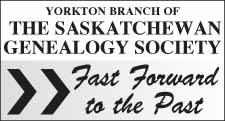The Yorkton Branch of the Saskatchewan Genealogical Society meets at the Yorkton Public Library on the second Tuesday of each month. New members are always welcome! Whether you are well on your way with genealogical research, or someone who is interested in getting started with your family tree but you don't know where to begin, you will find friendly and knowledgeable assistance with the group. The next meeting will be on Tuesday, May 13Trappers at 7PM. Please join us!
The Saskatchewan Genealogical Society "Bulletin" is a publication that has many interesting and helpful articles on genealogy research. The December, 1987 issue has an article from a presentation by Marie-Louise Perron of Sask. Archives in Regina. The article is titled "French and the Metis". Excerpts from this article tell us that the French who came to Canada were from the North and North-West coastal area of France. They settled in Quebec with similar people as in France. To find Francophones across North America, it is helpful to follow the fur trade routes, such as Mississippi, Louisiana, Saskatchewan, Oregon, and the West Coast.
When the economy reached low periods, there was cross-border migration in the New England region to look for work. Boston had cotton mills which attracted Francophone workers. There were two peak periods of movement: mid 1880's and mid-1920's, with a lot of activity in Rhode Island and New York. In Western Canada, Wakaw, Duck Lake and Carleton were important centres. An immigration office was set up at Duck Lake. French counts attempted to make a settlement in the Whitewood area.
Saskatchewan fur trading forts were busy places; if one company would build a fort, a rival company would do the same, each trying to outdo the other in attracting trappers. "One of the earliest forts was Isle La Crosse, 1776-1850's-known as the rowdiest and most dangerous. Journals of fur trade days in Hudson Bay Archives, Winnipeg. Wealth of material there, in book form and micro film. Letters from George Simpson sent to his superiors often mentioned individuals working with him: names, dates, occupations and where they were going for furs."
The blending of the French and the First Nations resulted in the Metis. "Up-country' marriages were essentially common-law, but a legal marriage in the eyes of the people. The legal union between a French man and an Indian woman was very complicated, and resulted in a relationship that gave the wife many business duties connected with her husband's trapping work, as well as acting as a liaison between the trapping companies and the Indian people.
The article goes on to state that if modern-day genealogists are researching Metis or Francophone family connections, they must be able to read French, as the early documents were all written in French.
The "Bulletin" is a very informative publication that has articles, stories, and sometimes questions from people looking for information on long-ago family members. Just log on to the SGS site to find out more.
Every family has a story: discover yours with the Yorkton branch of the Saskatchewan Genealogical Society. For more information call Dave at 783-1093 or Glenn at 782-7969.



